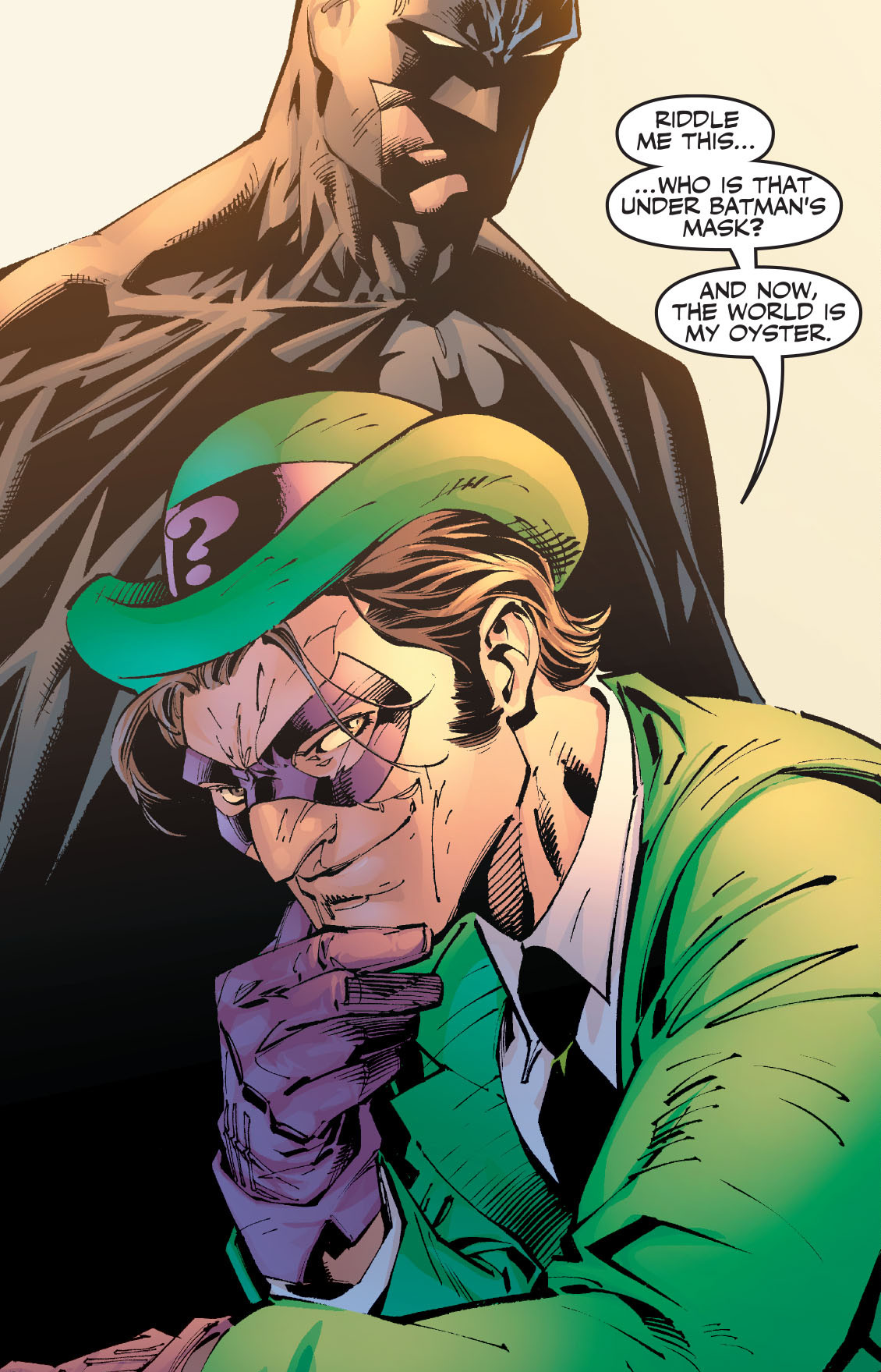Post by Z451 on Jan 14, 2014 1:56:48 GMT

The Riddler
The Riddler is obsessed with riddles, puzzles and word games.
He delights in forewarning both Batman and the police of his capers by sending them complex clues.
With this self-conscious use of a gimmick, the Riddler's crimes are flamboyant and ostentatious.
The character is depicted as wearing a domino mask either with a green suit and bowler hat, or a green unitard with question mark prints.
A black, green, or purple question mark serves as his visual motif.
The Riddler is typically portrayed as a smooth-talking yet quirky character, deemed insane by the courts of intense obsessive compulsion and neurosis.
This was first introduced in the 1966 issue of Batman (titled, "The Riddle-less Robberies of the Riddler") in which he tries to refrain from leaving a riddle, but fails.
This compulsion has been a recurring theme, as shown in a 1999 issue of Gotham Adventures, in which he tried to commit a crime without leaving a riddle, but fails: "You don't understand... I really didn't want to leave you any clues.
I really planned never to go back to Arkham Asylum.
But I left you a clue anyway.
So I... I have to go back there. Because I might need help. I... I might actually be crazy."
It is a theme further explored in the 2003 Batman Adventures story "Free Man", where Riddler, officially ruled a free man, sells communication technology he developed to an electronics firm only to be pursued by shadow assassins; he turns to Batman for help, only to break down when their trap succeeds and Riddler is seized by an overpowering sense of survivor guilt.
The Riddler was popularized by Frank Gorshin’s Emmy-nominated portrayal in the 1960s Batman television series.
Jim Carrey played the Riddler in the 1995 film Batman Forever with Gorshin as his inspiration.
The character was also featured in Batman: The Animated Series (voiced by John Glover) and The Batman (voiced by Robert Englund).
In both series, he was portrayed as a smooth-talking intellectual who presented genuinely challenging riddles.
While the former utilized his traditional wardrobe and appearance, the latter reimagined him with a Marilyn Manson-esque sense of style.
Since the first animated series and Batman Forever, Riddler often carries a trick "question mark" cane.
Unlike most of the other prominent members of Batman's rogues gallery, the Riddler is not a psychopathic murderer; rather, he is a malignant narcissist with an enormous ego.
He commits his crimes in order to flaunt his intellectual superiority and a large portion of his crimes are non-violent in nature.
While the Riddler's behavior may often appear insane to some, it is in fact the result of a deep-seated neurosis.
As such Batman's direct conflicts with the Riddler are typically more cerebral than physical and usually involve defeating him non-violently.
Links
Batman Wiki
DC Wiki
Copyright Owner
DC Comics
Record:
W:
L:
He delights in forewarning both Batman and the police of his capers by sending them complex clues.
With this self-conscious use of a gimmick, the Riddler's crimes are flamboyant and ostentatious.
The character is depicted as wearing a domino mask either with a green suit and bowler hat, or a green unitard with question mark prints.
A black, green, or purple question mark serves as his visual motif.
The Riddler is typically portrayed as a smooth-talking yet quirky character, deemed insane by the courts of intense obsessive compulsion and neurosis.
This was first introduced in the 1966 issue of Batman (titled, "The Riddle-less Robberies of the Riddler") in which he tries to refrain from leaving a riddle, but fails.
This compulsion has been a recurring theme, as shown in a 1999 issue of Gotham Adventures, in which he tried to commit a crime without leaving a riddle, but fails: "You don't understand... I really didn't want to leave you any clues.
I really planned never to go back to Arkham Asylum.
But I left you a clue anyway.
So I... I have to go back there. Because I might need help. I... I might actually be crazy."
It is a theme further explored in the 2003 Batman Adventures story "Free Man", where Riddler, officially ruled a free man, sells communication technology he developed to an electronics firm only to be pursued by shadow assassins; he turns to Batman for help, only to break down when their trap succeeds and Riddler is seized by an overpowering sense of survivor guilt.
The Riddler was popularized by Frank Gorshin’s Emmy-nominated portrayal in the 1960s Batman television series.
Jim Carrey played the Riddler in the 1995 film Batman Forever with Gorshin as his inspiration.
The character was also featured in Batman: The Animated Series (voiced by John Glover) and The Batman (voiced by Robert Englund).
In both series, he was portrayed as a smooth-talking intellectual who presented genuinely challenging riddles.
While the former utilized his traditional wardrobe and appearance, the latter reimagined him with a Marilyn Manson-esque sense of style.
Since the first animated series and Batman Forever, Riddler often carries a trick "question mark" cane.
Unlike most of the other prominent members of Batman's rogues gallery, the Riddler is not a psychopathic murderer; rather, he is a malignant narcissist with an enormous ego.
He commits his crimes in order to flaunt his intellectual superiority and a large portion of his crimes are non-violent in nature.
While the Riddler's behavior may often appear insane to some, it is in fact the result of a deep-seated neurosis.
As such Batman's direct conflicts with the Riddler are typically more cerebral than physical and usually involve defeating him non-violently.
Links
Batman Wiki
DC Wiki
Copyright Owner
DC Comics
Record:
W:
L:

